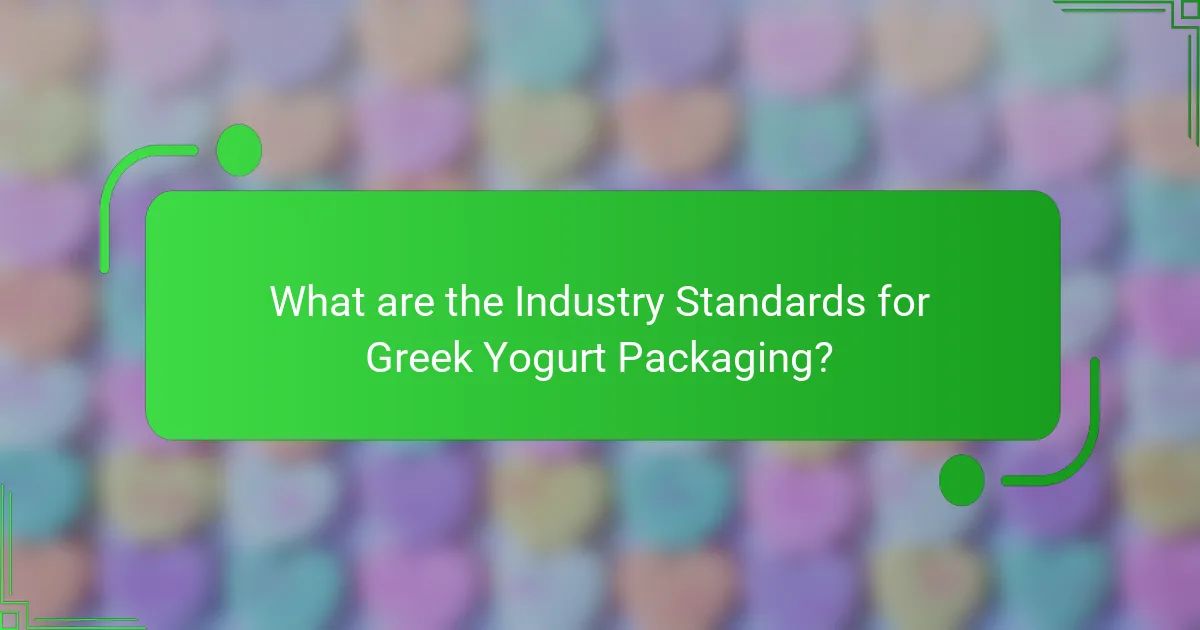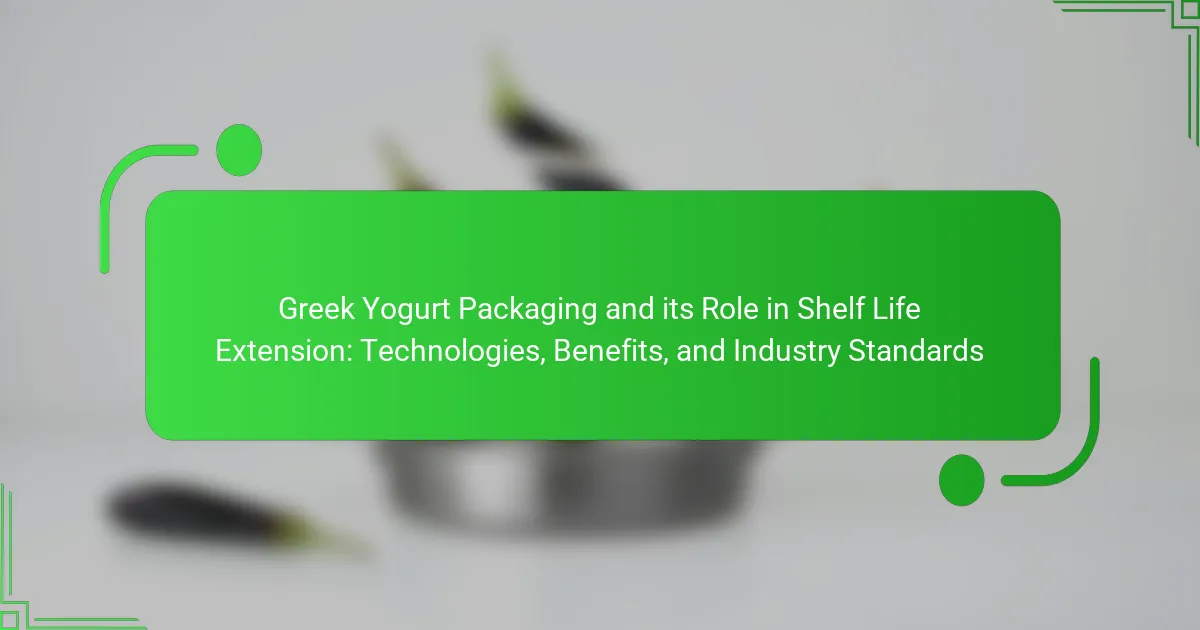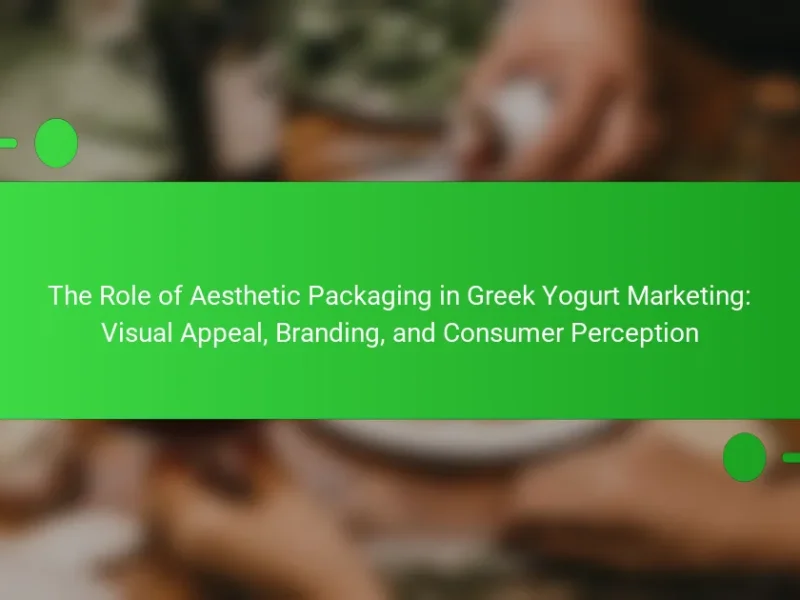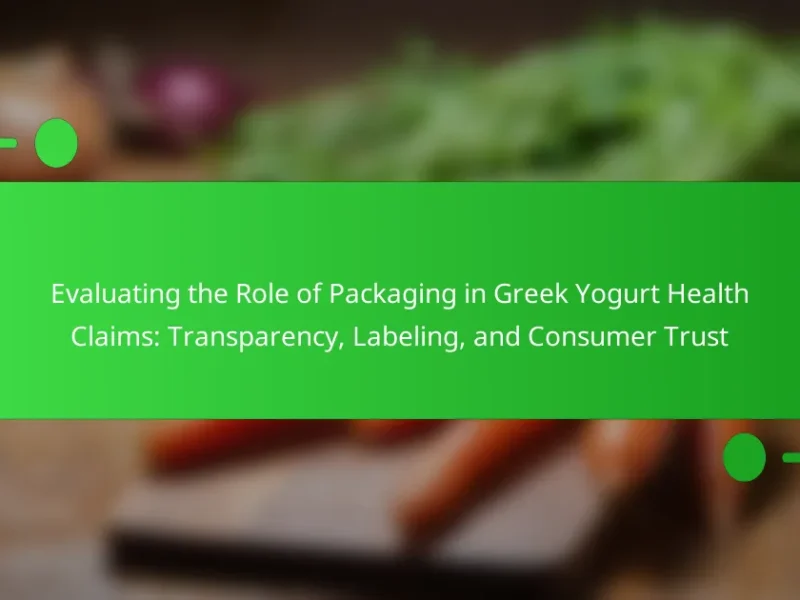Greek yogurt packaging encompasses the materials and methods used to contain and protect Greek yogurt products, playing a vital role in extending their shelf life. Effective packaging prevents contamination and minimizes exposure to light, oxygen, and moisture, all of which can lead to spoilage. Common materials used include plastic containers, glass jars, and foil seals, with advanced techniques such as vacuum sealing and modified atmosphere packaging further enhancing freshness. Industry standards dictate that packaging must be food-grade and compliant with safety regulations, while sustainable practices are increasingly prioritized. Overall, proper packaging significantly impacts product quality, consumer satisfaction, and market success.

What is Greek Yogurt Packaging and its Role in Shelf Life Extension?
Greek yogurt packaging refers to the materials and methods used to contain and protect Greek yogurt products. This packaging plays a crucial role in extending the shelf life of Greek yogurt. Effective packaging prevents contamination and minimizes exposure to light, oxygen, and moisture. These factors can lead to spoilage and quality degradation over time.
Common packaging materials include plastic containers, glass jars, and foil seals. These materials are designed to create a barrier against external elements. Research indicates that vacuum sealing and modified atmosphere packaging can significantly prolong product freshness. A study published in the Journal of Dairy Science highlights that proper packaging can extend yogurt shelf life by several weeks.
In summary, Greek yogurt packaging is essential for maintaining product quality and safety. It directly impacts the shelf life and consumer satisfaction.
How does Greek Yogurt Packaging contribute to preserving freshness?
Greek yogurt packaging preserves freshness by creating a barrier against air and contaminants. This barrier minimizes exposure to oxygen, which can lead to spoilage. Additionally, advanced packaging materials often include moisture control features. These features help maintain the ideal humidity level within the container. The use of airtight seals further prevents the entry of bacteria. Research shows that proper packaging can extend shelf life by several weeks. For instance, vacuum-sealed containers significantly reduce spoilage rates. Effective packaging also helps retain the product’s flavor and nutritional value. Overall, the right packaging technology is essential for maintaining the quality of Greek yogurt.
What materials are commonly used in Greek Yogurt Packaging?
Common materials used in Greek yogurt packaging include plastic, glass, and paperboard. Plastic containers are lightweight and provide a good moisture barrier. They are often made from polypropylene or polyethylene. Glass jars are recyclable and offer excellent protection against contamination. Paperboard is used for outer packaging and provides structural support. These materials help maintain product freshness and extend shelf life.
How do these materials affect the shelf life of Greek Yogurt?
Packaging materials significantly influence the shelf life of Greek yogurt. High-barrier materials reduce oxygen and moisture transfer. This limits microbial growth and spoilage. Additionally, light-blocking packaging prevents degradation of sensitive nutrients. The use of vacuum sealing further extends freshness by minimizing air exposure. Research indicates that yogurt stored in optimal packaging can last up to three weeks longer. Studies show that proper packaging can maintain quality and safety standards effectively.
Why is shelf life important for Greek Yogurt products?
Shelf life is crucial for Greek yogurt products to ensure safety, quality, and consumer satisfaction. A longer shelf life allows for extended distribution and storage, reducing waste. Greek yogurt is a perishable product, and its freshness directly impacts taste and texture. The presence of live cultures in Greek yogurt can diminish over time, affecting probiotic benefits. Proper packaging can significantly enhance shelf life by protecting against contamination and spoilage. For instance, vacuum-sealed containers can limit oxygen exposure, preserving flavor and nutritional value. Studies show that Greek yogurt can maintain optimal quality for up to three weeks under proper refrigeration. Therefore, understanding shelf life is essential for manufacturers and consumers alike.
What factors influence the shelf life of Greek Yogurt?
The shelf life of Greek yogurt is influenced by several key factors. These include storage temperature, packaging type, and the presence of preservatives. Greek yogurt should be stored at or below 40°F (4°C) to maintain its freshness. Packaging that is airtight and light-resistant can help prevent spoilage. Additionally, some manufacturers may add preservatives to extend shelf life. The production date and handling practices also significantly affect yogurt longevity. Proper handling during transport and storage minimizes contamination risks. These factors collectively determine how long Greek yogurt remains safe and palatable for consumption.
How does packaging technology help in extending shelf life?
Packaging technology extends shelf life by creating barriers against environmental factors. These barriers reduce exposure to oxygen, moisture, and light. Oxygen can cause spoilage and rancidity in food products. Moisture can lead to microbial growth, while light can degrade sensitive nutrients. Advanced materials like vacuum packaging and modified atmosphere packaging are commonly used. For instance, vacuum packaging removes air to slow down oxidation. Modified atmosphere packaging replaces air with gases like nitrogen to inhibit spoilage. Studies show that proper packaging can extend shelf life by 30% or more. This is crucial for perishable items like Greek yogurt, ensuring quality and safety for consumers.
What are the technological advancements in Greek Yogurt Packaging?
Technological advancements in Greek yogurt packaging include the use of biodegradable materials and smart packaging technologies. Biodegradable materials reduce environmental impact while maintaining product integrity. Smart packaging incorporates sensors that monitor freshness and quality. These sensors can detect changes in temperature and humidity, providing real-time data. Additionally, vacuum sealing techniques extend shelf life by minimizing oxygen exposure. Modified atmosphere packaging (MAP) replaces air with protective gases to preserve flavor and texture. Innovations in barrier films enhance protection against moisture and light. Enhanced labeling technologies improve consumer information and traceability. These advancements collectively contribute to improved product quality and sustainability in the yogurt industry.
What types of packaging technologies are currently used?
Current packaging technologies for Greek yogurt include vacuum packaging, modified atmosphere packaging, and retort packaging. Vacuum packaging removes air to reduce oxidation and spoilage. Modified atmosphere packaging replaces air with gases like nitrogen to extend shelf life. Retort packaging involves heat treatment to eliminate bacteria and enhance preservation. Each technology contributes to maintaining product freshness and safety. Studies show that these methods can significantly prolong the shelf life of dairy products, including Greek yogurt, by minimizing microbial growth and spoilage.
How do active and intelligent packaging systems work?
Active and intelligent packaging systems enhance the preservation of products like Greek yogurt. Active packaging interacts with the contents to extend shelf life, often using substances that absorb moisture or oxygen. Intelligent packaging provides real-time information about the product’s condition. This can include indicators for freshness or spoilage. These systems utilize sensors or indicators embedded in the packaging. Research shows that such technologies can significantly reduce spoilage rates. For instance, studies indicate that active packaging can extend the shelf life of dairy products by up to 50%. This effectiveness is critical for maintaining quality in Greek yogurt.

What are the Benefits of Effective Greek Yogurt Packaging?
Effective Greek yogurt packaging enhances product freshness and extends shelf life. It protects against contamination and moisture, which can spoil yogurt. Proper packaging materials, like barrier films, reduce oxygen exposure. This minimizes spoilage and maintains flavor integrity. Effective designs also improve convenience for consumers. They facilitate easy opening and resealing. Additionally, appealing packaging can enhance brand visibility. Studies show that well-designed packaging can increase sales by attracting customers. Overall, effective packaging is crucial for quality preservation and market success.
How does packaging impact consumer perception of Greek Yogurt?
Packaging significantly influences consumer perception of Greek yogurt. Attractive packaging can enhance perceived quality and freshness. Research shows that consumers often associate unique designs with premium products. Clear labeling of nutritional benefits can also increase trust and purchase intent. Additionally, sustainable packaging appeals to environmentally conscious consumers. Studies indicate that packaging color and material affect emotional responses. For instance, bright colors can evoke a sense of healthiness. Overall, effective packaging strategies can lead to higher sales and brand loyalty.
What role does packaging design play in marketing Greek Yogurt?
Packaging design plays a crucial role in marketing Greek yogurt. It influences consumer perception and purchase decisions. Eye-catching designs attract attention on store shelves. Packaging communicates brand identity and product quality. Effective design can highlight health benefits and unique attributes. Research shows that 70% of purchasing decisions are made at the shelf. Therefore, appealing packaging can significantly boost sales. Additionally, functional packaging preserves freshness and extends shelf life. This dual role enhances both marketing and product longevity.
How can packaging enhance convenience for consumers?
Packaging enhances convenience for consumers by facilitating easy access and storage of products. It often includes features like resealable openings, portion control, and easy-to-read labels. Resealable packaging allows consumers to use only what they need and keep the rest fresh. Portion control packaging helps in managing serving sizes, reducing waste. Clear labeling provides essential information on nutrition and expiration dates, aiding informed choices. Easy-to-handle designs enable simpler transportation and usage. Studies show that convenient packaging can increase consumer satisfaction and repeat purchases.
What environmental considerations are associated with Greek Yogurt Packaging?
Greek yogurt packaging raises several environmental considerations. The materials used, such as plastic and aluminum, contribute to waste. Many yogurt containers are not recyclable, leading to increased landfill contributions. Additionally, the production of these materials often involves high energy consumption and carbon emissions. The transportation of packaged products also has an environmental impact due to fuel usage. Some companies are exploring biodegradable packaging options to mitigate these effects. Consumer demand for sustainable packaging is driving innovation in the industry. Overall, the environmental footprint of Greek yogurt packaging is a significant concern that affects sustainability efforts.
What sustainable packaging options are available for Greek Yogurt?
Sustainable packaging options for Greek yogurt include biodegradable containers, recyclable materials, and compostable films. Biodegradable containers break down naturally over time, reducing landfill waste. Recyclable materials, such as certain plastics and glass, can be processed and reused. Compostable films made from plant-based materials decompose in composting environments. These options help minimize environmental impact. According to a 2021 study by the European Commission, sustainable packaging can significantly reduce carbon footprints in the dairy industry.
How does eco-friendly packaging influence consumer choices?
Eco-friendly packaging significantly influences consumer choices by appealing to their environmental values. Research indicates that 66% of consumers prefer brands that use sustainable packaging. This preference drives purchasing decisions, especially among younger demographics. Consumers associate eco-friendly packaging with quality and brand responsibility. Brands that adopt such practices often experience increased loyalty and positive brand perception. A study by Nielsen found that 73% of millennials are willing to pay more for sustainable products. Therefore, incorporating eco-friendly packaging can enhance market competitiveness and consumer engagement.

What are the Industry Standards for Greek Yogurt Packaging?
Industry standards for Greek yogurt packaging include material, labeling, and environmental regulations. Packaging materials must be food-grade and protect against moisture and light. Common materials include plastic containers, glass jars, and aluminum foil. Labels must include nutritional information, ingredients, and allergen warnings. Compliance with FDA regulations is mandatory for safety and labeling. Additionally, sustainable packaging practices are increasingly emphasized. This includes using recyclable or biodegradable materials. Studies show that proper packaging can extend shelf life by reducing spoilage and contamination.
What regulations govern Greek Yogurt Packaging in different regions?
Regulations governing Greek yogurt packaging vary by region. In the European Union, the General Food Law sets safety and labeling standards. The U.S. Food and Drug Administration regulates yogurt labeling under the Federal Food, Drug, and Cosmetic Act. Specific packaging requirements include ingredient disclosure and nutritional information. In Canada, the Food and Drugs Act mandates similar labeling practices. Each region enforces compliance through inspections and penalties. This ensures consumer safety and product integrity across markets.
How do these regulations ensure food safety and quality?
Regulations ensure food safety and quality by establishing strict standards for production and packaging. These standards require manufacturers to follow hygienic practices during yogurt production. They also mandate testing for harmful bacteria and contaminants. Quality control measures are enforced to monitor the freshness and nutritional content of Greek yogurt. Additionally, regulations specify labeling requirements to inform consumers about ingredients and allergens. Compliance with these regulations reduces the risk of foodborne illnesses. The FDA and USDA oversee these regulations, ensuring that food products meet safety criteria. This oversight builds consumer trust in the food supply.
What labeling requirements must be met for Greek Yogurt Packaging?
Greek yogurt packaging must meet specific labeling requirements. These include the product name, which must clearly state “Greek yogurt.” The label must also include the net weight of the product. Nutritional information is required, detailing serving size, calories, and nutrient content. Ingredients must be listed in descending order by weight. Allergen information should be clearly indicated, especially for dairy. The packaging must display the manufacturer’s name and contact information. Expiration or sell-by dates are also mandatory for consumer safety. Compliance with FDA regulations ensures that these requirements are met for consumer protection.
How do manufacturers ensure compliance with industry standards?
Manufacturers ensure compliance with industry standards through rigorous testing and quality control processes. They conduct regular audits to assess adherence to safety and quality regulations. Training programs for staff are implemented to maintain awareness of standards. Documentation and record-keeping are essential for traceability and accountability. Collaboration with regulatory bodies helps manufacturers stay updated on changes in standards. Utilizing certified materials and technologies is crucial for compliance. Manufacturers also engage in third-party evaluations to validate their practices. These measures collectively ensure that products meet established industry benchmarks.
What testing methods are used to evaluate packaging effectiveness?
Common testing methods used to evaluate packaging effectiveness include tensile strength testing, moisture barrier testing, and gas permeability testing. Tensile strength testing measures the force required to break the packaging material. This helps determine durability during handling and transportation. Moisture barrier testing assesses how well packaging prevents moisture ingress. This is crucial for maintaining the quality of perishable items like Greek yogurt. Gas permeability testing evaluates the packaging’s ability to restrict gas exchange. This is important for extending shelf life by minimizing oxidation. Other methods include sensory evaluation and shelf-life studies. Sensory evaluation involves assessing product quality through taste, smell, and appearance over time. Shelf-life studies track how packaging affects product stability under various storage conditions. Each method provides insights into the packaging’s performance and its impact on product longevity.
How can manufacturers stay updated on changing regulations?
Manufacturers can stay updated on changing regulations by subscribing to industry newsletters and regulatory agency alerts. These resources provide timely updates on new laws and compliance requirements. Attending industry conferences and trade shows also helps manufacturers network and learn about regulatory changes. Engaging with industry associations can offer insights and advocacy on relevant regulations. Regularly reviewing government websites ensures manufacturers are aware of official announcements. Utilizing compliance management software can streamline tracking of regulatory changes. Training staff on regulatory updates fosters a culture of compliance within the organization.
What best practices should be followed in Greek Yogurt Packaging?
Best practices in Greek yogurt packaging include using materials that provide an effective barrier against moisture and oxygen. This helps maintain product freshness and extends shelf life. Packaging should be tamper-evident to ensure consumer safety. Clear labeling of nutritional information and ingredients is essential for transparency. Additionally, portion control packaging can help reduce food waste. Using recyclable materials aligns with sustainability goals. Proper sealing techniques prevent contamination and spoilage. Finally, maintaining consistent temperature during storage and transport is crucial to preserve quality.
How can producers optimize their packaging processes for quality?
Producers can optimize their packaging processes for quality by implementing advanced materials and technologies. Utilizing high-barrier films can significantly reduce oxygen and moisture ingress. This helps maintain the freshness and extends the shelf life of Greek yogurt. Employing vacuum sealing techniques can also minimize spoilage by removing air from the package. Additionally, incorporating smart packaging technologies can provide real-time freshness indicators. These indicators alert consumers about the product’s quality status. Regular quality control checks during the packaging process ensure consistency and adherence to industry standards. Research shows that optimizing packaging can lead to a 20% reduction in spoilage rates. This directly benefits producers by lowering waste and increasing consumer satisfaction.
What tips can be implemented to enhance shelf life through packaging?
To enhance shelf life through packaging, use airtight seals to prevent moisture and oxygen exposure. Moisture can lead to spoilage and microbial growth. Oxygen exposure can accelerate oxidation, affecting taste and quality. Incorporate vacuum packaging to remove air from the container. This method significantly reduces spoilage rates. Utilize barrier materials that prevent light and oxygen [censured]. Light can degrade sensitive ingredients in yogurt. Implement modified atmosphere packaging to replace air with inert gases. This technique further extends shelf life by slowing down spoilage. Employ temperature control in packaging to maintain optimal storage conditions. Studies show that maintaining a stable temperature can double shelf life. Lastly, consider using biodegradable materials that also provide effective barrier properties. These materials can enhance sustainability while preserving product quality.
Greek yogurt packaging encompasses the materials and methods used to contain and protect Greek yogurt products, playing a vital role in extending shelf life by preventing contamination and minimizing exposure to light, oxygen, and moisture. The article examines various packaging materials such as plastic, glass, and paperboard, and highlights advanced technologies like vacuum sealing and modified atmosphere packaging that enhance freshness and prolong shelf life. It also discusses the importance of shelf life for consumer satisfaction, the impact of packaging on consumer perception, and the environmental considerations associated with packaging choices. Additionally, the article outlines industry standards and best practices to ensure compliance and optimize packaging processes for quality and sustainability.


